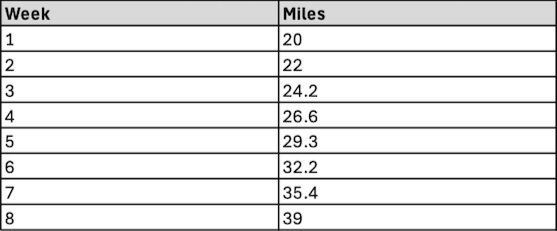How to increase mileage
“How many miles should I be running in a week, and if I want to get better, how should I go about running more?” Ask these questions, and the internet will reliably direct you to the 10% Rule, which has achieved folk wisdom status. The idea is that to avoid increasing your mileage too quickly, you should never increase your mileage by more than 10% week over week. Sounds pretty reasonable. But let’s look at an example:
Our hypothetical runner here has basically doubled their weekly mileage in 8 weeks. This could either be totally disastrous, or just fine depending on that runner’s background: if their comfortable baseline weekly mileage is 20, where we started, then increasing this quickly is inviting an injury because we’re not giving their body time to adapt to the new, higher-stress workload before increasing it again. However, if this runner is used to running 50 miles a week, and what we’re looking at is a period of ramping back up after simply taking a couple weeks off, then this progression would probably be overly cautious.
What are some other ways to think about it?
Jack Daniels offers a suggestion here which I agree can be a good option: after any increase in mileage, hold that mileage steady for a number of weeks, say 3-5, before increasing again. The increase itself should be equal to the number of days per week that you’re running: if you run 4 days per week, then you could increase your weekly mileage by 4 miles every several weeks. This will give your body time to adapt to what you’re asking of it.
Additionally, I would insert cutback weeks, where you intentionally drop your mileage by 20-40% to give yourself time to recover. So for our hypothetical runner, whose baseline comfortable mileage is 20 miles per week, a more sustainable progression that I might include in a training plan would consist of running 20 miles for 3 weeks, then dropping down to 15 for a week, followed by 3 weeks at 24 miles, and so forth.
The golden rule of running applies here: whatever the question is, the answer is “it depends!” While the 10% rule might work for some runners some of the time, it can land you in hot water pretty quickly if not applied judiciously. There are many different ways to think about increasing mileage, but with all of them it’s important to think about your own training history and to pay close attention to the signals you’re getting from your body. Whether it’s me or someone else, having a coach to help you navigate these questions is incredibly helpful!


